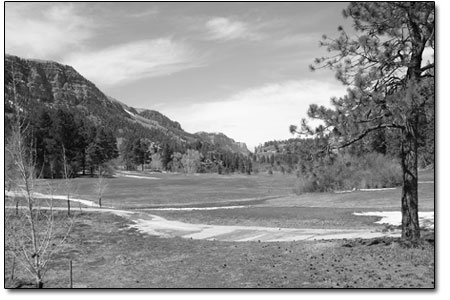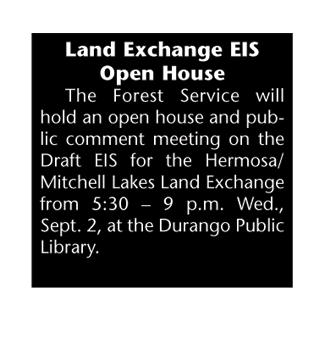|
| ||||||
| Golf swap gets the go-ahead SideStory: Swapping comments
by Missy Votel The Glacier Club is steadily inching its way northward. Last Tuesday, the private golf resort north of Durango took another step toward its controversial expansion south of the popular Haviland Lake Recreation Area. The U.S. Forest Service released a Draft Environmental Impact Statement on the Glacier Club’s proposed land swap, which would trade 265 acres of San Juan National Forest north of the club for three private forest inholdings. The club proposes to use the parcel to add nine holes to its 27-hole course and 125 executive homes. In exchange, the Forest Service will gain control of the inholdings: 160 acres in Hermosa Park, east of Purgatory; 160 acres near Mitchell Lakes, north of Hermosa; and the 10-acre Iron Clad mining claim, in the Weminuche Wilderness southeast of Silverton. The EIS, which will be open to public comment for 45 days, analyzed three alternatives, in addition to the requisite “no action.” The preferred action was that of Alternative 2, which closely matched the Glacier Club’s proposal. It included the 265 acres and a half-mile, paved access road. However, public concessions were added, such as a parking area near the popular Golf Wall climbing area, an additional 1.7 miles of trail along Lower Elbert Creek and a half-mile trail north of the Chris Lake Campground. The Forest Service also agreed to add nearly 6 miles of existing user-created trails in the surrounding area into its trail system. The preferred alternative did not protect the historic Animas Canyon Toll Road, which runs through the federal parcel. The Glacier Club approached the Forest Service in 2002 with the proposal, which set off several years of negotiations as well as a firestorm of protest. Rockwood resident and founder of the Save Haviland Recreation Area group, Richard Robinson, said the preferred alternative was disappointing but not surprising. “There’s never been any doubt this would be the case,” he said. Robinson said there are three major areas of concern. The first is that the land swap is not financially equitable, with the value of the Haviland parcel being much higher than that of the three remote parcels, especially given development potential. “The EIS did not give appraisal values, which in my mind is putting the cart before the horse, especially given those houses will be selling for $1 million,” Robinson said. His second concern was that the EIS did not account for the value of the road easement, which would cross Forest Service land to reach the Glacier Club parcel. Typically, such easements cost tens of thousands, and sometimes hundreds of thousands of dollars. “I don’t like just giving that land away,” he said. The third concern stemmed from loss of the old toll road, which according to a 2008 archeological study was found to be a candidate for national historic preservation. Although suggestions were made in the EIS to mitigate this loss, Robinson said the EIS lacked enforcement measures. Perhaps the biggest concern voiced by Robinson and others is over the loss of recreational opportunities and open space. Robinson noted the remote inholdings, which are mostly inaccessible in winter and far from town, are a poor substitute for the nearby, year-round offerings of the Haviland and Chris Park area. “The normal person would not go to Hermosa Park in the winter, whereas this is right out our door.” He also said trophy homes on surrounding ridges would be an intrusion on the idyllic setting. “Having houses on the cliffs looking down on you would change the experience of what is, for all intents and purposes, a wilderness area,” he said. North county resident Pete Turner, whose family homesteaded land nearby, concurred. He said development will forever change the ambience at the Chris Park campground area, which he sees as even more of an asset as the area grows. “I’m concerned about the Chris Park Road becoming an emergency access road and ruining the solitude,” he said. “A lot of people ski on that road in the winter, but it’s going to be pretty hard to do if it’s plowed.”
According to Forest Supervisor Mark Stiles, any time the Forest Service has the opportunity to acquire private inholdings, it takes a hard look at the proposal. “The prime reason is these parcels could pose even bigger problems down the road if they ever get developed,” he said. However, the Glacier Club deal was particularly sweet, given the Hermosa, and to a lesser extent Mitchell Lakes, parcels, which have been on the Forest Service’s wish list for some time. “We can only do a land exchange when it’s in the public interest,” he said. “These three parcels, especially the Hermosa Park one, have been high on our list.” He said the Iron Clad parcel will allow the Forest Service jurisdiction over a mining site in a wilderness area, and the Hermosa and Mitchell Lakes are valuable because of their proximity to the Hermosa Roadless Area. Furthermore, the Hermosa Park parcel is home to a unique riparian habitat, pristine watershed and native species such as cutthroat trout. “It’s especially important because two streams come together there, and there’s a willow bottom there that should be thriving but isn’t,” he said. Both Robinson and Turner noted they are not against acquiring the inholdings but with the method being used. Although the Forest Service contends prior attempts to strike a deal with landowners fell short, Robinson said money could be available through the federal Land and Water Conservation fund. “There’s a lot of money there, it just wasn’t available under Bush, but I expect a great change to occur in the near future.” Nevertheless, both agree the current deal is a classic case of robbing Peter to pay Paul. “The benefits they’d be gaining are the same ones they’d be losing,” he said. “The question is, what price do you pay?” However, Stiles noted the proposal is far from being a done deal. “As with any land exchange, we encourage people to comment,” he said. “I hope people realize we are a long way from being done.” In addition to the 45-day comment period, Stiles said all comments will have to be reviewed and worked into the final proposal. The first EIS took two years to complete and netted 500 comments. Although the preferred alternative resembles the one proposed by the Glacier Club, it was modified “a great deal” over the years by the applicants, he said. “We whittled down the boundaries as best we could,” he said. “If people study the alternatives, they’ll see we included their comments and suggestions. And the final EIS could include a piece of any of the comments.” Glacier Club CEO Malcolm Dunlevie refused comment for this story. However, Allen Poe of Western Land Group, the Denver-based consultant facilitating the land transaction, said he felt the preferred alternative was fair and equitable. “We’re anxious to read the EIS,” he said.
|
In this week's issue...
- January 25, 2024
- Bagging it
State plastic bag ban is in full effect, but enforcement varies
- January 26, 2024
- Paper chase
The Sneer is back – and no we’re not talking about Billy Idol’s comeback tour.
- January 11, 2024
- High and dry
New state climate report projects continued warming, declining streamflows




